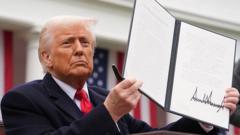In a significant development for global trade, President Donald Trump’s controversial tariff strategy appears to be bearing fruit, particularly with Japan entering into negotiations with the U.S. Following months of deliberations, the two nations have reached a tentative agreement, marking what can be viewed as a pivotal moment in Trump’s economic maneuvering.
From the outset, U.S. representatives have emphasized the potential for a favorable deal with Japan—an idea that has finally materialized into a concrete agreement. Japan, a powerhouse in global trade, now faces a 15% tariff on its exports to the U.S., which, while higher than the U.K.'s 10%, is seen as a step towards appeasement rather than a triumph for American exporters.
Diplomatic channels had previously been fraught with tension, particularly given Japan's hardline stance during negotiations, which deviated from the typically cordial norms of international discourse. The Japanese finance minister referenced the nation's substantial $1.1 trillion investment in U.S. Treasury bonds as leverage in discussions. A potential sell-off of these bonds had alarmed markets following Trump’s tariff announcements earlier in the year.
The implications of this agreement extend beyond Japan, setting a significant precedent as other economic alliances—from the European Union to Canada—scrutinize the terms of trade as a deterrent for retaliatory measures. Japan's arrangement may encourage similar concessions among economic partners, especially in light of ongoing threats of higher tariffs from the Trump administration.
As the deal unfolds, Japan has managed to safeguard significant agricultural imports while increasing its rice purchases from the U.S. However, American automotive exports to Japan face challenges in gaining traction due to existing consumer preferences.
Despite fears of intensified tariffs on allied nations, expressed through the upcoming levy set for August 1, Japan has opted to sign this deal, possibly influenced by internal political dynamics. Other nations, such as Indonesia and the Philippines, have also navigated similar negotiations, highlighting a broader acceptance of U.S. tariff policies previously deemed unacceptable.
The financial ramifications of these tariffs are becoming evident, contributing over $100 billion to U.S. revenues this year alone, contrasting sharply with past reliance on income taxes. Nevertheless, American consumers will ultimately bear the impact of these tariffs, as rising product prices loom on the horizon due to additional inflationary pressures.
Market analysts have noted that the subsequent drop in the U.S. dollar’s value complicates the cost of imports amid this tariff landscape, causing instability in safe-haven investment patterns and prompting businesses to hedge against currency fluctuations.
As the initial stages of this global trade war evolve, the U.S.-Japan agreement symbolizes a notable success for Trump, helping to stave off criticisms of indecision in his policy approach. However, broader economic uncertainties remain, indicating that while immediate challenges may be met with short-term victories, long-term forecasts for international trade dynamics remain complex and unpredictable.





















